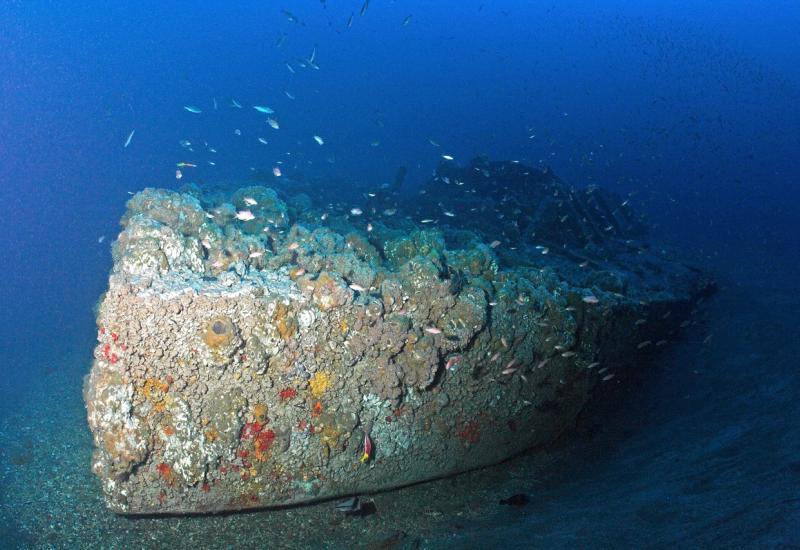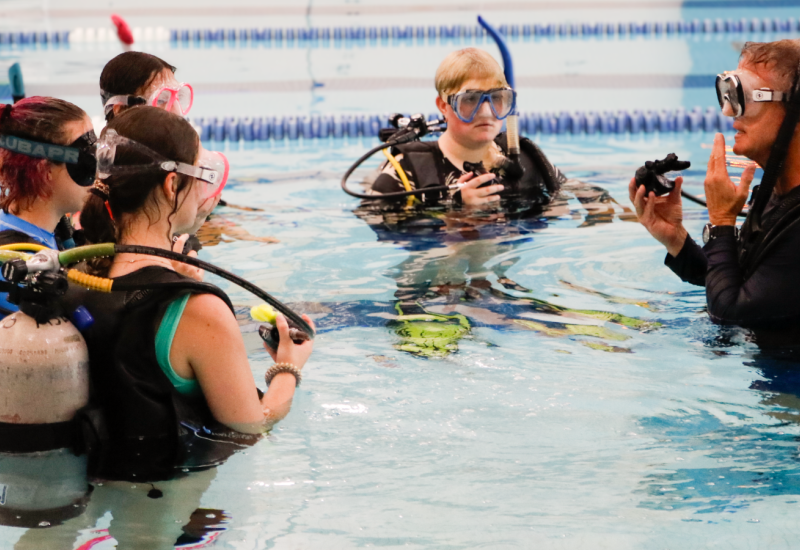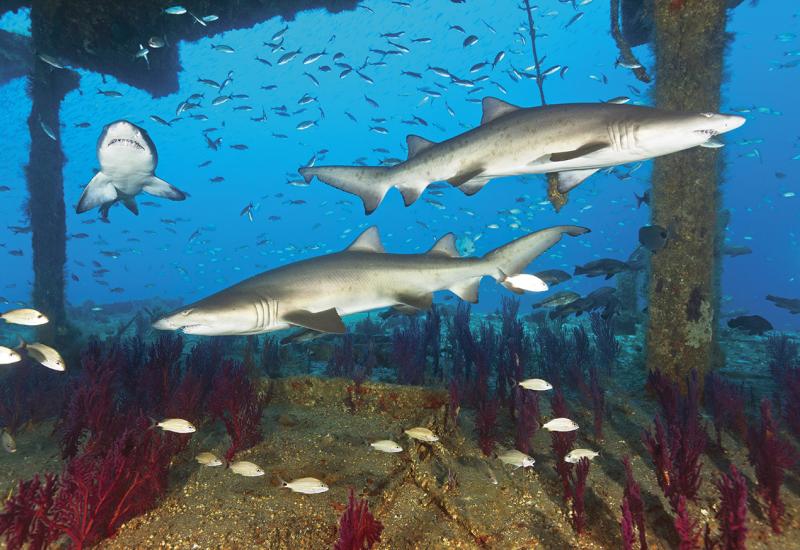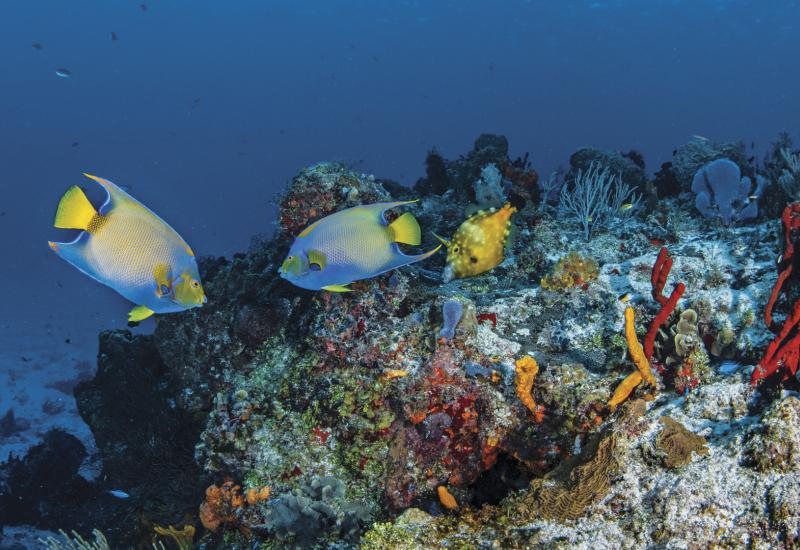Ghosts in the Graveyard: N.C. Shark Diving
 |
| Only on the wrecks of North Carolina can you get shots this close to fearsome looking sand tiger sharks. |
April 2001
By Robert D. Decker
Long known for world-class wreck diving, North Carolina's "Graveyard of the Atlantic" is rapidly gaining recognition as North America's premier shark diving destination. Like sleek, gray ghosts, big sand tiger sharks prowl these wrecks year-round, offering divers a rare chance for up-close encounters without the need for feeding or baiting.
Man Meets Shark
While it's not unusual to spot an occasional sand bar, thresher or nurse shark mixed in with sand tiger schools (hammerhead, bull and dusky sharks even make occasional, fleeting appearances), sand tiger sharks are the most common and approachable species.
The first time you see the business end of an 11-foot sand tiger shark--that slightly deranged face and the mouth best described as an exploding riot of teeth--it's easy to forget that, when treated with respect, these wild ocean predators are generally docile. Think Barney Fife in Arnold Schwarzenegger's body and you get the idea. Of course, Barney always carried at least one bullet, so don't get cocky. Aggressive displays are rare but possible when a shark is provoked or harassed. Touching or grabbing a sand tiger could result in a close encounter of the unpleasant kind.
Tips for Getting Close
While sand tigers don't seem to mind the presence of divers, they can get skittish when approached directly or aggressively. You're more likely to get close by kneeling on the bottom than finning after them. Sand tigers have been known to swim between the legs of divers standing on the bottom and will frequently approach stationary divers within an arm's length.
Keep in mind that the largest concentration of sand tigers isn't always directly on the shipwreck. Schools are often found off to the side, out in the sand. If sharks aren't visible on the wreck, try swimming out to the edge of the visibility range (keeping the wreck in sight to ensure a safe return, of course) and you're likely to find dozens of sharks lined up in rows.
Thanks to their ferocious looks and large size, sand tigers make excellent subjects for underwater photography and videography. The best results are usually obtained by using a 20mm or 28mm wide-angle lens. This allows the photographer to fill the frame without having to approach too closely. Should a sand tiger approach within a few feet, wide-angle lenses allow photographers to get impressive close-ups of the shark's head.
Top Shark Sites
While you can find sand tiger schools on or near most Carolina wrecks, four sites off Cape Lookout produce the most consistent encounters.
Atlas
Depth: 125 feet. Skill Level: Intermediate.
A new hotspot for shark encounters, this partially intact shipwreck sits upright in about 125 feet of water, though portions of the large wreck reach within 90 feet of the surface. The 430-foot tanker, torpedoed in 1942 by a German submarine, is typical of the sites favored by sand tiger schools, mature wrecks with numerous openings and abundant fish life. Since Atlas rests close to Cape Lookout Shoals, visibility at this site is typically restricted to around 60 feet, but watching sharks materialize from the haze adds extra excitement to the encounters.
Caribsea
Depth: 90 feet. Skill Level: Novice.
One of the areas most popular sites for shark encounters, Caribsea has been home to a large congregation of sand tigers for several years. With a maximum depth of just 90 feet, and much of the wreck 10 to 20 feet shallower, this site provides divers with longer bottom times than many of the other popular shark sites. Torpedoed in 1942 by the U-158, the prominent feature of the 250-foot freighter is the bow section. Though the bow is still largely intact, it is starting to collapse and divers should avoid penetration. Vis is variable and can sometimes be less than 40 feet.
Aeolus
Depth: 110 feet. Skill Level: Intermediate.
Part of North Carolinas artificial reef program, the Aeolus has only recently been providing a home for a few sand tigers. This 409-foot-long transatlantic cable layer originally rested intact on its starboard side. The hurricanes of 1996 ravaged the site, breaking the monstrous ship into three distinct sections and turning part of the wreckage upright. Today, the site has the appearance of a natural shipwreck and provides plenty of opportunities for penetration. Because of its large size, divers are advised to limit their explorations to the section of the wreck their boat is tied to. While sand tigers aren't seen in the numbers or frequency they are on some other sites, this is a popular location for a second dive and does provide an occasional shark encounter.
Papoose
Depth: 120 feet. Skill Level: Intermediate to advanced.
For several years, the wreck of the Papoose was the areas best known and most popular site for shark diving. Since the end of the 1999 hurricane season, however, sand tiger shark encounters at this site have been infrequent. Sunk by the U-124 during World War II, this large oil tanker provides a world-class wreck dive, with or without the presence of sharks. Because of its proximity to the Gulf Stream, visibility of 100 feet or more is not unusual at this site during the summer months.
Where Else?
Shark diving isn't restricted to the sites visited by Cape Lookout dive operators. To the north, charters running out of Hatteras and Ocracoke can provide divers with sand tiger encounters, as can southern operators in Wilmington and Southport.
Rules of Engagement
With its unique snaggle-toothed grin, graceful movement and classic streamlined body, the sand tiger shark is a joy to view and photograph. Because of their docile temperament and the lack of any feeding stimuli, these encounters are virtually risk-free if you follow some commonsense rules.
Don't touch. Resist the urge to touch or chase the sharks. Sand tigers are curious about-but also slightly wary of-divers. They will approach you if you remain stationary and non-threatening.
Always leave an exit. Leave an open exit path when encountering sharks inside a shipwreck. Cornering a shark may provoke an aggressive reaction.
Leave the speargun topside. Like all sharks, sand tigers are excited by the blood and thrashing of freshly speared fish and have been known to confiscate the catches of spearfishermen.
 |
Shark Biology 101: The Sand Tiger Shark (Carcharius Taurus)
Size > Sand tigers normally obtain a maximum length of about 11 feet in the Atlantic. On occasion, larger specimens are spotted.
dentification > Sand tigers are grey-brown on their upper bodies and light grey or white on their undersides. This counter- shading makes them difficult to see from above or below. They have two dorsal fins of approximately the same length and a pointed nose. The upper portion of their tail fin is substantially longer than the lower lobe.
Behavior > They frequently swim with their mouths slightly open, giving a clear view of multiple rows of fang-like teeth. These teeth are shed and replaced about every two weeks, providing a popular souvenir for divers.
Unlike many other species of shark, they are frequently seen hovering motionless along the bottom. Lacking a swim bladder, sand tigers have large, oily livers. The oil is much lighter than seawater and helps provide buoyancy. Sand tigers are also known to swim to the surface, taking large gulps of air to aid with buoyancy.
Diet > Sand tigers feed on small, slow bony fishes, bottom dwellers and crabs. Unlike the "super sharks," such as the great white, their small teeth are not suitable for tearing flesh from larger prey.
Reproduction > The waters off the coast of North Carolina are thought to be this sharks breeding grounds. Fresh breeding wounds seen on females lend credence to this theory. Typically each mother will produce two pups.
The Dive Briefing
The Boat Ride > Most popular North Carolina shark and wreck dives are located 20 to 45 miles offshore and visited on two-tank day trips. Boats vary from small six packs to 30-passenger vessels, though most do not provide drinks or snacks, so bring your own. Conditions may turn rough unexpectedly, so motion sickness medication is always a good idea just in case.
Certification. > For full-day charters, North Carolina operators typically require an open- water certification with at least one ocean dive to a depth of 80 feet in the last six months. Advanced certification is highly recommended.
The Rules > North Carolina operators don't dictate profiles or behavior to their customers. It's up to you to dive within the limits of your equipment, experience and training. Pay close attention to pre-dive briefings. Operators know these wrecks well and will provide a wealth of information on everything from the wrecks history to dive techniques and where to find the most sharks.
Water Conditions > Influenced by both the warm Gulf Stream and cold Labrador Current, diving off the coast of North Carolina can be the easiest diving ever or it can be a challenging experience, depending on season, location and the unpredictable whims of the Atlantic. Conditions are at their best during the May to October dive season, though sand tigers can be found year-round.
Visibility > Count on an average of 50 to 70 feet on most offshore sites, but on calm days it can peak at 100 feet or more.
Temperature > Gear up for mid-70s to low 80s during the summer. A full 3mm suit is recommended over shorties for added protection from cuts and scrapes. In the winter, plan on heavy neoprene, hood and gloves or a dry suit for temps in the low 60s.
Currents > Currents vary according to conditions, seasons and sites. Dive operators will brief you on-site. Use caution when swimming near wreck openings, which can amplify current flow.
Equipment > This is the open ocean. A safety sausage, mirror and loud noisemaker are smart precautions.
Dive Operators
Cape Lookout >
-
Olympus Dive Center (800) 992-1258, (252) 726-9432; Web: www.olympusdiving.com
-
Discovery Diving Company (252) 728-2265; Web: www.discoverydiving.com
-
Bottom Time Dive Center (800) 52-SCUBA, (910) 347-2826; Web: www.bottomtime.com
-
Pelican Divers Inc., (800) 488-4220, (800) 735-4228; Web: www.pelicandivers.com
-
Atlantis Diving Company (252) 728-6244; Web: http://atlantis4.hypermart.net
-
Vision Quest Dive Center (910) 327-0787
-
Divocean Dive Center (252) 726-3575; Web: www.divocean-dive-center.com
-
Diver Down (252) 240-2043; Web: www.diverdownscubadiving.com
-
Sea Tales Scuba Charters (252) 792-7097; Web: www.seatales.com
Cape Fear >
-
Scuba South Diving Co. (910) 457-5201; Web: www.scubasouthdiving.com
-
Bottom Time Wilmington (800) NITROX-1, (910) 397-0181; Web: www.bottomtime.com
-
Aquatic Safaris (910) 392-4FUN; Web: www.aquaticsafaris.com
Cape Hatteras >
-
Diamond Shoals Dive Center (252) 995-4021
-
Outer Banks Diving (252) 986-1056; Web: www.outerbanksdiving.com
Nags Head >
- Outer Banks Dive Center (252) 449-8349; Web: www.obxdive.com
For More Information
For more information on sand tiger shark biology and behavior, visit www.nautilusproductions.com/sandtigersharks.
A dive club known as BFDC has a great web site with pictures and details on popular N.C. wrecks, at www.nc-wreckdiving.com.
For North Carolina vacation planners and general tourism information, call (800) SUNNY-NC or visit www.sunnync.com.
|| |---|
|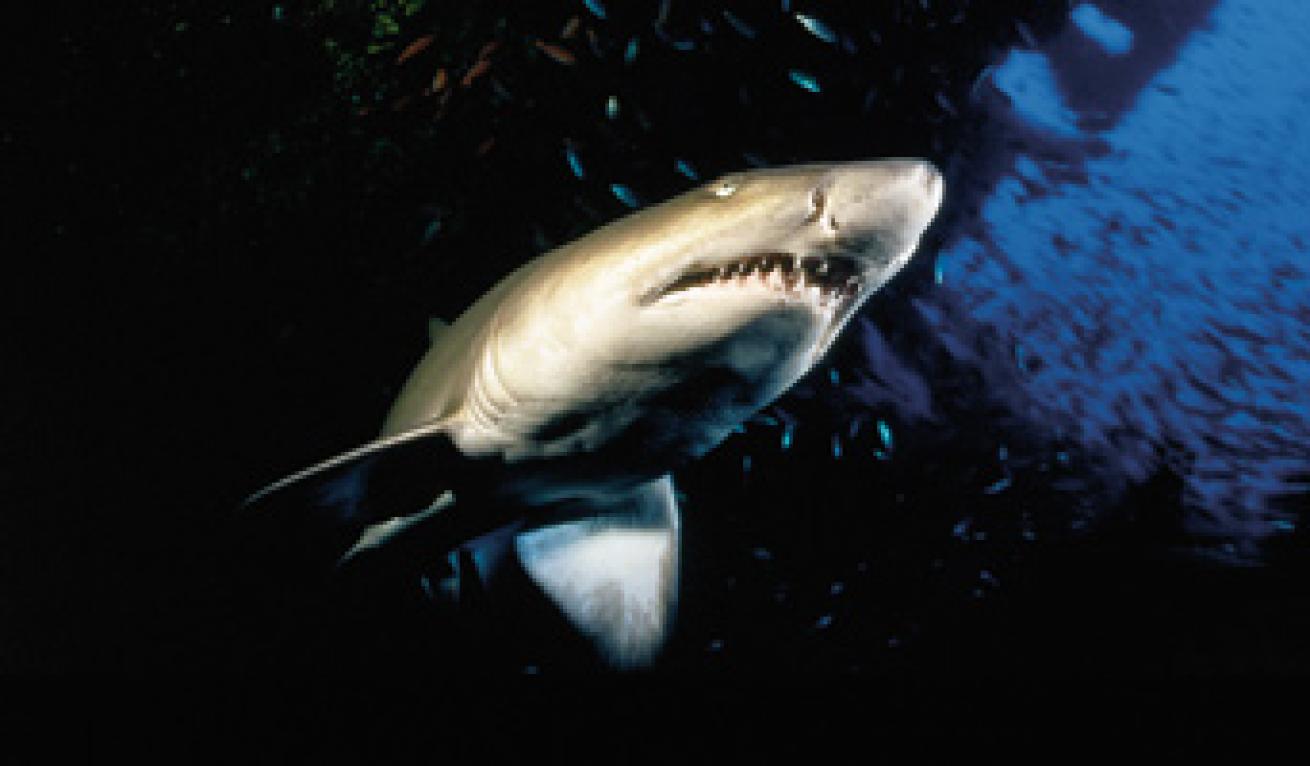
| |Only on the wrecks of North Carolina can you get shots this close to fearsome looking sand tiger sharks.|
April 2001
By Robert D. Decker
Long known for world-class wreck diving, North Carolina's "Graveyard of the Atlantic" is rapidly gaining recognition as North America's premier shark diving destination. Like sleek, gray ghosts, big sand tiger sharks prowl these wrecks year-round, offering divers a rare chance for up-close encounters without the need for feeding or baiting.
Man Meets Shark
While it's not unusual to spot an occasional sand bar, thresher or nurse shark mixed in with sand tiger schools (hammerhead, bull and dusky sharks even make occasional, fleeting appearances), sand tiger sharks are the most common and approachable species.
The first time you see the business end of an 11-foot sand tiger shark--that slightly deranged face and the mouth best described as an exploding riot of teeth--it's easy to forget that, when treated with respect, these wild ocean predators are generally docile. Think Barney Fife in Arnold Schwarzenegger's body and you get the idea. Of course, Barney always carried at least one bullet, so don't get cocky. Aggressive displays are rare but possible when a shark is provoked or harassed. Touching or grabbing a sand tiger could result in a close encounter of the unpleasant kind.
Tips for Getting Close
While sand tigers don't seem to mind the presence of divers, they can get skittish when approached directly or aggressively. You're more likely to get close by kneeling on the bottom than finning after them. Sand tigers have been known to swim between the legs of divers standing on the bottom and will frequently approach stationary divers within an arm's length.
Keep in mind that the largest concentration of sand tigers isn't always directly on the shipwreck. Schools are often found off to the side, out in the sand. If sharks aren't visible on the wreck, try swimming out to the edge of the visibility range (keeping the wreck in sight to ensure a safe return, of course) and you're likely to find dozens of sharks lined up in rows.
Thanks to their ferocious looks and large size, sand tigers make excellent subjects for underwater photography and videography. The best results are usually obtained by using a 20mm or 28mm wide-angle lens. This allows the photographer to fill the frame without having to approach too closely. Should a sand tiger approach within a few feet, wide-angle lenses allow photographers to get impressive close-ups of the shark's head.
Top Shark Sites
While you can find sand tiger schools on or near most Carolina wrecks, four sites off Cape Lookout produce the most consistent encounters.
Atlas
Depth: 125 feet. Skill Level: Intermediate.
A new hotspot for shark encounters, this partially intact shipwreck sits upright in about 125 feet of water, though portions of the large wreck reach within 90 feet of the surface. The 430-foot tanker, torpedoed in 1942 by a German submarine, is typical of the sites favored by sand tiger schools, mature wrecks with numerous openings and abundant fish life. Since Atlas rests close to Cape Lookout Shoals, visibility at this site is typically restricted to around 60 feet, but watching sharks materialize from the haze adds extra excitement to the encounters.
Caribsea
Depth: 90 feet. Skill Level: Novice.
One of the areas most popular sites for shark encounters, Caribsea has been home to a large congregation of sand tigers for several years. With a maximum depth of just 90 feet, and much of the wreck 10 to 20 feet shallower, this site provides divers with longer bottom times than many of the other popular shark sites. Torpedoed in 1942 by the U-158, the prominent feature of the 250-foot freighter is the bow section. Though the bow is still largely intact, it is starting to collapse and divers should avoid penetration. Vis is variable and can sometimes be less than 40 feet.
Aeolus
Depth: 110 feet. Skill Level: Intermediate.
Part of North Carolinas artificial reef program, the Aeolus has only recently been providing a home for a few sand tigers. This 409-foot-long transatlantic cable layer originally rested intact on its starboard side. The hurricanes of 1996 ravaged the site, breaking the monstrous ship into three distinct sections and turning part of the wreckage upright. Today, the site has the appearance of a natural shipwreck and provides plenty of opportunities for penetration. Because of its large size, divers are advised to limit their explorations to the section of the wreck their boat is tied to. While sand tigers aren't seen in the numbers or frequency they are on some other sites, this is a popular location for a second dive and does provide an occasional shark encounter.
Papoose
Depth: 120 feet. Skill Level: Intermediate to advanced.
For several years, the wreck of the Papoose was the areas best known and most popular site for shark diving. Since the end of the 1999 hurricane season, however, sand tiger shark encounters at this site have been infrequent. Sunk by the U-124 during World War II, this large oil tanker provides a world-class wreck dive, with or without the presence of sharks. Because of its proximity to the Gulf Stream, visibility of 100 feet or more is not unusual at this site during the summer months.
Where Else?
Shark diving isn't restricted to the sites visited by Cape Lookout dive operators. To the north, charters running out of Hatteras and Ocracoke can provide divers with sand tiger encounters, as can southern operators in Wilmington and Southport.
Rules of Engagement
With its unique snaggle-toothed grin, graceful movement and classic streamlined body, the sand tiger shark is a joy to view and photograph. Because of their docile temperament and the lack of any feeding stimuli, these encounters are virtually risk-free if you follow some commonsense rules.
Don't touch. Resist the urge to touch or chase the sharks. Sand tigers are curious about-but also slightly wary of-divers. They will approach you if you remain stationary and non-threatening.
Always leave an exit. Leave an open exit path when encountering sharks inside a shipwreck. Cornering a shark may provoke an aggressive reaction.
Leave the speargun topside. Like all sharks, sand tigers are excited by the blood and thrashing of freshly speared fish and have been known to confiscate the catches of spearfishermen.
|| |---|
|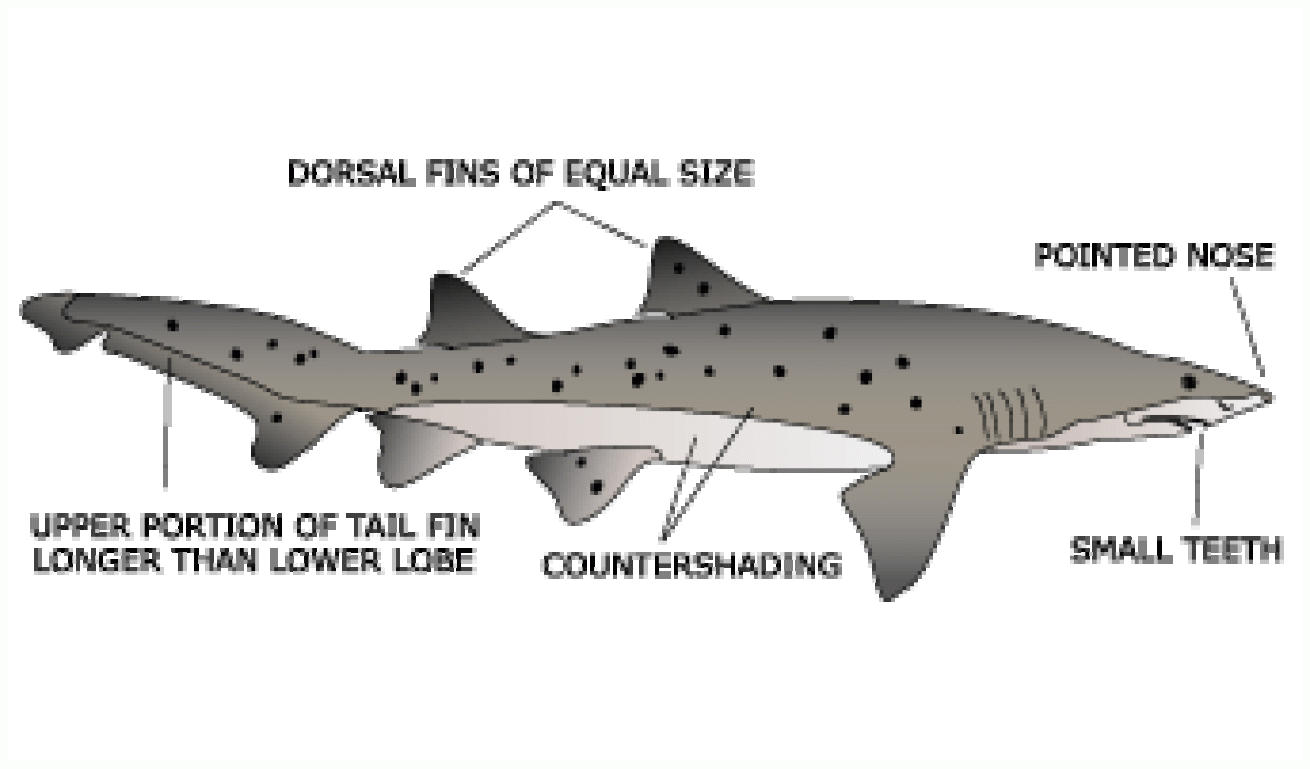
|
Shark Biology 101: The Sand Tiger Shark (Carcharius Taurus)
Size > Sand tigers normally obtain a maximum length of about 11 feet in the Atlantic. On occasion, larger specimens are spotted.
dentification > Sand tigers are grey-brown on their upper bodies and light grey or white on their undersides. This counter- shading makes them difficult to see from above or below. They have two dorsal fins of approximately the same length and a pointed nose. The upper portion of their tail fin is substantially longer than the lower lobe.
Behavior > They frequently swim with their mouths slightly open, giving a clear view of multiple rows of fang-like teeth. These teeth are shed and replaced about every two weeks, providing a popular souvenir for divers.
Unlike many other species of shark, they are frequently seen hovering motionless along the bottom. Lacking a swim bladder, sand tigers have large, oily livers. The oil is much lighter than seawater and helps provide buoyancy. Sand tigers are also known to swim to the surface, taking large gulps of air to aid with buoyancy.
Diet > Sand tigers feed on small, slow bony fishes, bottom dwellers and crabs. Unlike the "super sharks," such as the great white, their small teeth are not suitable for tearing flesh from larger prey.
Reproduction > The waters off the coast of North Carolina are thought to be this sharks breeding grounds. Fresh breeding wounds seen on females lend credence to this theory. Typically each mother will produce two pups.
The Dive Briefing
The Boat Ride > Most popular North Carolina shark and wreck dives are located 20 to 45 miles offshore and visited on two-tank day trips. Boats vary from small six packs to 30-passenger vessels, though most do not provide drinks or snacks, so bring your own. Conditions may turn rough unexpectedly, so motion sickness medication is always a good idea just in case.
Certification. > For full-day charters, North Carolina operators typically require an open- water certification with at least one ocean dive to a depth of 80 feet in the last six months. Advanced certification is highly recommended.
The Rules > North Carolina operators don't dictate profiles or behavior to their customers. It's up to you to dive within the limits of your equipment, experience and training. Pay close attention to pre-dive briefings. Operators know these wrecks well and will provide a wealth of information on everything from the wrecks history to dive techniques and where to find the most sharks.
Water Conditions > Influenced by both the warm Gulf Stream and cold Labrador Current, diving off the coast of North Carolina can be the easiest diving ever or it can be a challenging experience, depending on season, location and the unpredictable whims of the Atlantic. Conditions are at their best during the May to October dive season, though sand tigers can be found year-round.
Visibility > Count on an average of 50 to 70 feet on most offshore sites, but on calm days it can peak at 100 feet or more.
Temperature > Gear up for mid-70s to low 80s during the summer. A full 3mm suit is recommended over shorties for added protection from cuts and scrapes. In the winter, plan on heavy neoprene, hood and gloves or a dry suit for temps in the low 60s.
Currents > Currents vary according to conditions, seasons and sites. Dive operators will brief you on-site. Use caution when swimming near wreck openings, which can amplify current flow.
Equipment > This is the open ocean. A safety sausage, mirror and loud noisemaker are smart precautions.
Dive Operators
Cape Lookout >
Olympus Dive Center (800) 992-1258, (252) 726-9432; Web: www.olympusdiving.com
Discovery Diving Company (252) 728-2265; Web: www.discoverydiving.com
Bottom Time Dive Center (800) 52-SCUBA, (910) 347-2826; Web: www.bottomtime.com
Pelican Divers Inc., (800) 488-4220, (800) 735-4228; Web: www.pelicandivers.com
Atlantis Diving Company (252) 728-6244; Web: http://atlantis4.hypermart.net
Vision Quest Dive Center (910) 327-0787
Divocean Dive Center (252) 726-3575; Web: www.divocean-dive-center.com
Diver Down (252) 240-2043; Web: www.diverdownscubadiving.com
Sea Tales Scuba Charters (252) 792-7097; Web: www.seatales.com
Cape Fear >
Scuba South Diving Co. (910) 457-5201; Web: www.scubasouthdiving.com
Bottom Time Wilmington (800) NITROX-1, (910) 397-0181; Web: www.bottomtime.com
Aquatic Safaris (910) 392-4FUN; Web: www.aquaticsafaris.com
Cape Hatteras >
Diamond Shoals Dive Center (252) 995-4021
Outer Banks Diving (252) 986-1056; Web: www.outerbanksdiving.com
Nags Head >
- Outer Banks Dive Center (252) 449-8349; Web: www.obxdive.com
For More Information
For more information on sand tiger shark biology and behavior, visit www.nautilusproductions.com/sandtigersharks.
A dive club known as BFDC has a great web site with pictures and details on popular N.C. wrecks, at www.nc-wreckdiving.com.
For North Carolina vacation planners and general tourism information, call (800) SUNNY-NC or visit www.sunnync.com.

